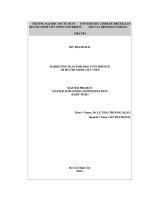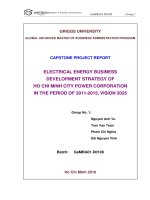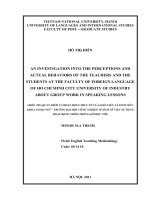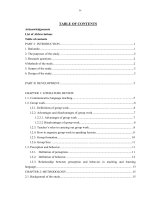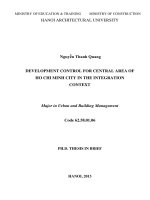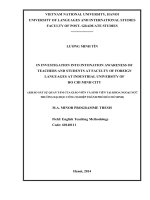DEVELOPMENT CONTROL FOR CENTRAL AREA OF HO CHI MINH CITY IN THE INTEGRATION CONTEXT
Bạn đang xem bản rút gọn của tài liệu. Xem và tải ngay bản đầy đủ của tài liệu tại đây (178.06 KB, 31 trang )
MINISTRY OF EDUCATION & TRAINING MINISTRY OF CONSTRUCTION
HANOI ARCHITECTURAL UNIVERSITY
Nguyễn Thanh Quang
DEVELOPMENT CONTROL FOR CENTRAL AREA OF
HO CHI MINH CITY IN THE INTEGRATION
CONTEXT
Major in Urban and Building Management
Code 62.58.01.06
PH.D. THESIS IN BRIEF
HANOI, 2013
1
This thesis has been completed in HANOI ARCHITECTURAL
UNIVERSITY
Supervisor: Professor Đỗ Hậu
Examiner 1: Prof. Dr. Nguyễn Trọng Hòa
Examiner 2: Dr. Đào Ngọc Nghiêm
Examiner 3: Prof. Dr. Lưu Đức Hải
The thesis is presented and defended at the Thesis Panel of: Hanoi
Architectural University at………h……., on …….……2013
The thesis is kept at the National library and the library of Hanoi
architectural University
2
LIST OF AUTHOR’S PUBLISHED RESEARCHES
Research Project:
1. Research at City (Hanoi) level: “Xây dựng và quản lý không gian
xanh trong các khu đô thị mới tại Hà Nội đến năm 2020 với sự
tham gia của cộng đồng”, 2008-2010, research member.
2. Research at Ministry level (Ministry of Construction): “Điều tra,
khảo sát, nghiên cứu đề xuất cơ chế chính sách cải tạo, chỉnh
trang, phát triển khu vực trung tâm Thành phố Hồ Chí Minh”,
năm 2010-2012, research member.
3. Research at City (Ho Chi Minh city) level: “Nghiên cứu khung
lồng ghép các yếu tố biến đổi khí hậu vào công tác quy hoạch đô
thị ở Thành phố Hồ Chí Minh”, năm 2009 – 2013, research
member.
Articles:
1. Toàn cầu hóa sự phát triển không gian của Trung tâm thành phố
Hồ Chí Minh – The “Quy hoạch Xây dựng” Journal - The
institute for Architecture and Urban and Rural Planning, No.33
(7) 2008.
2. Bức tranh phát triển và quản lý đô thị dưới tác động của hội nhập
quốc tế - The “Quy hoạch Xây dựng” Journal - The institute for
Architecture and Urban and Rural Planning, No. 60, 2012.
3. Giải pháp tăng cường kiểm soát phát triển khu trung tâm thành
phố Hồ Chí Minh – The Journal of Construction, no.2, 2013.
3
A. INTRODUCTION
1. Necessity of the research
The market economy and international integration, together
with promotion of industrialization and modernization has created
many powerful forces for social and economic development in
general and our country’s urban centers in particular. Thank to the
outstanding competitiveness compared with other regions, the urban
center is the most attractive to lure the interest of investors and
developers in commercial and service sectors. For these reasons, the
development of building are strongly surged and diversified in terms
of number and shape that made the urban management become more
complicated. The management is sometimes exceeded the control of
local government and its agencies, negatively impacted on the urban
land use, structure and space creation, and thus the negativities and
weaknesses revealed.
In centre of Ho Chi Minh City, the rate of space development
and construction activities are quickly and strongly. A large number
of office buildings, commercial centers, high-rise condominiums and
houses have appeared densely, but lacking of control.
The balanced and consistent development in city centre is a
goal set in the city development towards the international standard of
life and urban environment. In order to achieve the goal, the
enhancement of the space development control is an indispensable
solution and plays a key role in the urban management. From such
the necessity, the topic of “Development Control for Central Area of
Ho Chi Minh City in The Integration Context” is selected for this
PhD’s thesis with the major in urban and building management.
2. Research Objectives
Establishing the model of control, the apparatus structure and
criteria of development control for urban centres, as well as
enhancing the essential measures to improve the efficiency of
4
control activities for urban centers development in Vietnam and Ho
Chi Minh City in particular towards the international standards of
life and urban environment in international integration.
3. Object and Scope of the Research
3.1. Object of research
The research object is the development control of the existing
central area of Ho Chi Minh City within the process of implementing
the approved urban plans in terms of physical space or urban space.
The urban space is viewed as the space, architectural buildings,
green areas etc. that directly impact the appearance of the city and its
space (Law on Urban Planning).
3.2. Scope of Research
- Location:
The existing central business district of Ho Chi Minh City
(regulated as document No.2940/SQHKT – QHKTT issued by
Department of Planning and Architecture, sent to Project
Management’s Committee relevant to the construction planning of
Ho Chi Minh City’s central business district about 930ha,
comprising a part of District 1, District 3 and Binh Thanh District)
- Timing: until 2020 and vision to 2030
4. The Significance of the Research
- Scientific significance:
Concretizing, supplementing, perfecting and enriching the
ratiocination issues of urban management science in general and
controlling the urban development in particular, this has controlled
the development of the regions of urban center.
- Practical significance:
Contributing to the perfection and enhancement of urban
management performance in general and controlling the urban
development in particular, including urban centers to aim at
5
promoting the role, position and function of the urban centers in the
process of industrialization, modernization and international
integration of Vietnam's urban, as well as researching and training.
5. The contribution value/contents of the thesis:
- The clarification on theoretical basis for urban space
development control
- A proposal for Development control system for Ho Chi
Minh City’s space development with the Functional Top-down
Model. The system is independent and under the City Government
(Ho Chi Minh City’s people committee)
- A proposal for an apparatus for urban space development
control system, which is structured at three administrative levels:
city, district and ward.
- A set of criteria for spatial development control for Ho Chi
Minh City which consists of eight components focusing on the
management for basic activities of spatial use and development.
- The solutions to improve the efficiency of Ho Chi Minh
City’s urban space development control.
6. Structure of the thesis
Beside the introduction and conclusion, the thesis consists of 3
main chapters:
- Chapter 1: Overview of the development and development
control of Ho Chi Minh City’s existing central business district in
integration.
- Chapter 2: Scientific bases for the control and the
development control of the central business district in large cities
- Chapter 3: Some control solutions to develop Ho Chi Minh
City’s central business district in integration.
7. Basic definitions related to the research
6
- “Development”
- “Control”
- “Integration”
- “Urban centre”
- “Centre Area Space Development Control”
7
B. CONTENT OF THE THESIS
Chapter 1: OVERVIEW OF THE DEVELOPMENT AND
DEVELOPMENT CONTROL OF HO CHI MINH CITY’S
EXISTING CENTRAL AREA IN THE INTEGRATION
CONTEXT
1.1. Overview of the spatial development of central area in
Vietnam’s large Cities
In the process of development of constructed land in urban
towns (urban land), the central business district will be developed
and, especially the central business district of city grade 1 under
government (the national centers).
Under the influence of the market economy and the integration
trend, in urban center, the functional groups of banking and finance,
commerce and service have been trending towards the strong and
rapid development, overwhelming the other ones. As a result, site
coverage, plot ratio, floor area density and average high limit are
higher than those of others in the city. Many hotels, restaurants,
banks, supermarkets, newspaper publishing, telecommunications,
discotheques, office buildings etc. have occupied the prime
locations, replaced the housing, health and education projects, etc.
broken the planning and traditional landscape of the central business
district. Green area occupied only 1-2 % of the construction land,
causing the negativities and the cramped in the construction planning
and the central business district’s environment.
Development status of the central business districts in large
cities, especially cities under the government, has achieved the basic
results below:
- Many areas of central business district in cities have been
more beautiful, civilized and modern, but still keep the image of
planned space, value architectural works and specific characteristic
of planning, architecture and construction of central business district
in cities, such as the ancient towns, French towns.
8
- In order to re-develop, land use purpose in areas with the
building works that were inconsistent with central functions, low
economic efficiency etc. will be conversed in the central business
district. It not only increased the land value but also created the new
architectural and the urban space.
- The preservation, restoration and promotion of the values of
heritage, architecture, history, culture, religion etc. should be
focused on utilizing.
- The upgrading, improvement and modernization of the
technical infrastructure in central business district (sidewalks, street
lights, power supply, water supply and drainage); the embellishment
of streets and squares (railway stations, bus stations, public areas,
etc.); the construction of bridges, overpasses; the solidification of
embankments of streets, lakes and rivers; and the construction of the
public utilities etc. did enliven and diversify the spaces and activities
in the central business district and facilitate the business operations
and meet daily demand of residents.
Besides above results, there are some shortcomings:
- There has been a lack of legal bases for the consistent and
effective development, such as the detail plan and urban design,
regulations of planning management etc. The architecture status and
construction in the central business district of cities have been
inconsistent, disorder and un-discipline.
- The uncontrollability of high-rise buildings in some narrow
areas of the central business district, lakeside and surroundings of
public areas etc. has led to the overload of technical infrastructure,
traffic jam, polluted environment, decrease of green area and parking
lots etc. broken the landscape and the harmony of environment and
ecology in cities.
- The public areas, green areas, water surface, sidewalks, and
parks have been decreased due to the encroachment caused the
congestions, the disturbance and the cramped in urban centres and
9
lack of the harmony between the architectural works (man-made) and
natural environment (nature made).
- The unharmonious architecture, disorder signboards,
interlaced power lines, unsafe and encroachment of sidewalks and
streets etc. have causes disarrangement, uncivilized effects in many
areas belong to old and crowded towns.
- The status of projects, delayed and stagnant construction of
infrastructure component has not only been waste of investment
capital but also caused the disorder in cities.
1.2. Current development situation of Ho Chi Minh City’s
existing central area
The total land area of the existing city center is approximately
930 ha, comprising 678.69ha of civil zone, occupied 74.2% and
238.74ha of non-civil zone, occupied 25.8% (the zone served for
religion, industry, military and water surface, etc.)
In civil zone, residential area occupies 15.9%, public area
16.7%, commercial area 12.0%, transportation area 25.8%, green
area 3.8%. If compared with the public area (administration, culture
– sport, infrastructure, education and health), commercial and
service area occupies the high ratio in the functional correlation of
the urban centre and in economic structure of city centre.
After the Vietnam government mandated the Doi Moi Reform
in 1986 and from 90s of last century, Ho Chi Minh City’s central
business district has been developed and expanded towards the West
and the Northwest. The central business district was proposed to
adjust the scale by 2006, increased total area of 930ha. Under
impacts of the market economy and the Doi Moi Reform of
Vietnam’s Communist Party and State relevant to economic – social
development, mobilization of resources of all economic sectors etc.
the functions of banking, finance, commerce and service were
rapidly grown in Ho Chi Minh City’s central business district. They
10
grew fast as business value, transaction offices, services, land and
construction.
In central business district, the landscape architecture has been
improved as modernization, civilization, beautification and
cleanliness. The core of District 1’s centre with high-rise buildings,
strips of trees alongside the streets and green areas, such as 30/4
Park, 23/9 Park, etc. has created the harmony between natural
landscape and architecture works.
Besides, there are many cultural heritages, history monuments
to be preserved and embellished, such as People's Committee, Notre
Dame Cathedral, Ben Thanh Market, Children's Hospital, etc.
The low-rise areas and inconsistent landscape along Saigon River,
with existing functions are the close port, harbor and riverside parks to
be relocated to replace better and more lucrative others.
However, Ho Chi Minh City and its central business district
have been faced with difficulties and challenges in the development
process, such as the unstable economic growth, the development of
technical and social infrastructure not matching the fast ratio of
urbanization, the stagnant and cumbersome management of
government not matching the social demand. Many arising
negativities must be solved by the authorities. The government is
facing with difficulties in developing stably and consistently.
1.3. The current control of spatial development in Ho Chi Minh
City’s existing central area
The control of spatial development in central business district
is a synthetic activity, including many sections (land use, urban
planning and design, preservation, landscape and environment,
safety, transportation, etc.) belonging to the governmental authorities
(Construction, Natural Resources and Environment, Culture,
Transportation, Police, etc.) and divided as many levels being in
charge of specific forces.
11
In general, the status of construction, urban and spatial
development in central business district has been changing orderly
and consistently. The control of construction has been improving
effectively. The number of legal construction works has been
increasing, and otherwise.
Figure 1.1. Violations of construction and urban order in Ho Chi
Minh City, from 2009 to 2011
(Source: Ho Chi Minh City Construction Office)
Ho Chi Minh City’s urban management apparatus in general
and control of urban development in particular (including the central
business district) is structured as 3 levels with the participation of
many specialized sections to be undertaken by specific inspectors.
The coordination of the City Construction Inspector has been
accomplished consistently between levels as regulated. Besides, it
has to co-ordinate other authorities and specific inspectors. The
construction inspector force and other sections have been
strengthened in terms of organizations, human resources and
practical skills, knowledge to promote for supervising, inspecting,
violation handling, control of construction and urban order.
1.4. Review of relevant published researches
- Projects and scientific researches
- PhD’s dissertation
- Master’s dissertation
Year
Construction violation
(case)
Urban order violation
(case)
2009
6,142
(decreased 25% y-o-y)
85,187
2010
5,078
(decreased 17.3% y-o-y)
75,897
2011
4,564
(decreased 10.12% y-o-y)
40,515
12
1.5. Issues to be researched in the thesis
- Issues relevant to the development control and the spatial
development control in central business district of cities.
- Impact of the international integration on development and
urban management (opportunities and threats).
- Build the scientific bases of the spatial development control
in cities.
- Recommend the organizational model of the control
systems, the control apparatus and the control criteria. And, perfect
some main solutions to enhance the effect of the city’s development
control and the spatial development control in central business
district of Ho Chi Minh City.
Chapter 2: BACKGROUND FOR THE RESEARCH OF
CONTROL AND THE DEVELOPMENT CONTROL OF THE
CENTRAL AREA IN LARGE CITIES
2.1. Methodology
The thesis has used several methods, such as the expert
method, the information processing method, the materials, the
survey method, the forecasting method, the comparison method, etc.
2.2. Theoretical backgrounds for the spatial development control
in the central area
The thesis examines subjects of control activities, measures
of control activities, forms and modes of control, the organizational
model of control management system, etc.
13
2.3. Legal tools and bases for urban spatial development control
and central area.
The tools are used by the control apparatus for the spatial
development of cities in general and Ho Chi Minh City in particular,
comprising:
- Legal tools
- Planning and projection tools
- Organization – administration tools
- Education and popularization tools
- Economy, technique and technology tools and etc.
Three tools of legal, planning and projection are main tools in
the management and control of urban development. They are the
foundation for considering and evaluating the implementation of
controlled subjects in construction, investment and utilization of
public areas and works in the cities in general and the central
business district in popular.
2.4. Major impacts on the spatial development control
There are many direct and indirect impacts on the performance
and success of development control in the cities and the central area
the key factors comprises mechanisms, policies and legal
documents, urban planning and other specialties, planning and
implementation progress of the programs, projects, organizational
structure of control apparatus, association between levels and
relevant authorities and communist’s involvement.
2.5. The integration impacts on urban development and
management
The international integration taken place in countries in the
region and the world have the positive impacts (opportunities) and
the negative impacts (threats) on the development of economy and
society in general, construction, development and urban
14
management in particular, including the central area. The thesis has
researched opportunities and threats from the integration.
2.6. Orientation of the planning and the spatial development
control in Ho Chi Minh City’s central area
The thesis has researched the orientation of development
planning of the functional spaces of central business district as detail
design and plan of Ho Chi Minh City’s existing central business
district by Nikken Sekkei (Japan), the option was selected, approved
and researched as orientation of spatial development control in
central business district.
2.7. Lessons of the control and development control in cities
Chapter 3: SOLUTIONS FOR DEVELOPMENT CONTROL
IN HO CHI MINH CITY’S CENTRAL AREA IN
INTEGRATION CONTEXT
3.1. Purposes and requirements for the solutions
3.1.1. Purposes
The general purpose to build solutions for perfecting and
improving the performance of spatial development in cities in
general and central business districts in particular, included Ho Chi
Minh City and its central business district includes: targets for
development of economy and society, urban construction and
development, promotion of process of industrialization and
modernization, integration of international economics and regions;
improving the quality of life environment; developing civilized,
modern and stable cities; conserving and preserving the heritages,
ethic tradition, national character and culture.
15
3.1.2. Requirements
The proposed solutions have to meet basic requirements below
- Meet with the regulations, the regulations of panning
management, the urban architecture, the management regulations in
sections of land, housing natural resource and environment,
investment, construction, utilization of works and others.
- Ensure the comprehensive and consistent control of city’s
development and its central business district in construction
- Be scientific, realistic and applicable; make the positive
evolvement and improve the performance of the control.
- Ensure the balance between the State’s interest,
communities, organizations, enterprises and individuals in
construction and investment of cities.
- Ensure the fluency of the control, the transparency and
public disclosure in management and implementation, clear
assignment and decentralization; shirk responsibility and tasks.
- Handle strictly violations of the subordinated management
agencies and objects.
3.2. Principles and process to control the development of Ho Chi
Minh City’s central area
3.2.1. Principles
Activities to control the city development in general and its
central business district in particular, must obey the following
principles
- The comprehensiveness consistency
- The regularity and continuousness
- The public disclosure and transparency
- The justice and balance between interests
16
- The fluency, sensitiveness, diversification and flexibility
3.2.2. Objects and process of control
- Sort by type of works, developers and utilities
- Sort by specialized sections
3.3. The solutions recommended for spatial development control
in Ho Chi Minh City’s existing central area
3.3.1. The structural model for spatial control in the city
The recommended model to apply the system organization for
control in city (physical and material space or city space) is the
model of online controlled organizational system – functions. The
model is structured as 3 management levels
- City (province)
- District
- Ward (commune)
There are 3 levels in the organizational model of Ho Chi Minh
City
- Municipal agencies (department)
- Divisions (districts)
- Group/ Team (wards, townships, communes)
3.3.2. Apparatus structural model to control the spatial
development of Ho Chi Minh City and its central area
For Ho Chi Minh City: at the city level, the agency to control
the urban development will be a contact point belonging to the
People's Committee, out of control of Construction Department. The
Inspection Division belongs to Construction Department, in charge
of the administrative activities of the department and specialized
internal activities, co-ordination and control of city’s development in
concerned sections. The inspectors of Construction Department and
17
other functional departments are responsible for co-ordination with
the agency/department of urban development control in activities of
city’s spatial development control in necessary cases.
Main functions of agency/ department of urban spatial
development control:
- Consult the relevant authorities about the control of city
spatial development, including field of city spatial development
control.
- Implement the function of administrative control relevant to
construction investment, improvement, utilization of architecture
objects and public areas in the city; control the activities of
organizations and individuals in construction investment and
utilization of urban spaces (including central area)
Main duties of agency of urban development control:
- Supervise and control the activities of spatial urban
construction and utilization of individuals and organizations to
prevent the violations relevant to planning, projection and
regulations.
- Inspect and handle the violations of the organizations and
individuals in the spatial urban construction, investment and
utilization as regulations of planning, architecture planning
management, projection and Law.
- Coordinate with the hierarchical authorities and the
inspector force under other departments/ agencies in the control of
activities assigned duties.
For the organizational apparatus of agency of urban
development control in Ho Chi Minh City and its central business
district, the author recommends below:
The apparatus of urban development control shall be structured as 3
levels
18
- Control the cities directly under municipal People's
Committee, there will be a specialized division to control the central
business districts (similar to division of planning and architecture
management – central agency – of Ho Chi Minh City’s Department
of Planning and Architecture)
- Control the district’s cities directly under district People’s
Committee. For districts have a part of area in the central business
district, it shall have a separated division to control the development
in the central business district. The division must be under control of
district’s agency and division of urban development control in the
central business district, belonging to city’s agency of urban
development control.
- Control the ward, commune or township’s city.
Teams/groups to control wards in the central business district are
under control of district management agency and division of local
urban development control in the central business district (due to
some district have a part of area belong to the central business
district)
All hierarchical agencies of urban development control have to
be under administrative control of the peer authorities. They have to
co-ordinate and co-operate with the specialized inspection division
and relevant departments.
The apparatus to control the city’s development control
includes the State’s administrative apparatus relevant to urban
development of the city and the control activities of political – social
organizations, enterprises, communities and residents. The State’s
administrative agencies are leaders.
19
Figure 1.2. Organizational apparatus to control the development of
Ho Chi Minh City and its central area (recommended by the author)
Municipal level
District level
Ward/
commune level
Peoples’
Committee
in city
City’s urban control
Central control division
People’s
Committee
in district
District’s urban control
Central control team
Ward’s urban control
Participation of political – social organizations, enterprises, communities and
residents
Interdisciplinary
control
Interdisciplinary
control
Interdisciplinary
control
People’s Committee
in commune, ward and
township
Objects
City’s administrative control apparatus
City’s urban control apparatus
20
3.3.3. Recommendation for criteria of urban spatial
development control of Ho Chi Minh City and its central
business district
Table 1.2. Criteria of urban development control of Ho Chi Minh
City
N
o.
Criteria in
group
Criteria in details Requirement
1
Urban Planning
and Sectoral
Planning
1.1.
Implementing the urban and
sectoral planning; establishing the
regulations for architectural, urban
planning management and other
fields, regulations for building
uses and urban space in central
area.
1.2. Identifying
weaknesses of the
urban planning schemes and urban
management regulations for
review, modification and
improvement.
-
Comply with
the urban
planning,
regulations and
the law.
-
Comply with
the law
2
Urban
Infrastructure
2.1. Carry out programs, plans, projects
to renovate, upgrade the technical
infrastructure system.
2.2.
Exploit and use the infrastructure
facilities developed by public and
private sectors
-
Comply with
the approved
programs and
projects
-
Comply with
the law
3
Land, houses
and public
property
3.1.
Exploit and use land, water
surfaces, rivers belonged to the public
and private sectors
3.2.
Carry out housing programs,
projects
3.3. Use and management for houses
and public property
3.4. Issuing land-
use and property
owning right certificates
-
Comply with
the law and the
planning
-
Comply with
the programs
and plans
-
Comply with
the law
-
Comply with
the law
4
Feasibility
Studies and
technical
4.1. Steps for investment projects
establishment, appraisal and approval.
4.2. Steps for establishment, appraisal
-
Comply with
the law
-
Comply with
21
N
o.
Criteria in
group
Criteria in details Requirement
designs
and approval on technical designs, cost
estimation and construction survey.
4.3.
Standard, building codes
application by law
the law
-
Comply with
regulations
5 Pre-construction
5.1.Site clearance
5.2.Ground-breaking Conditions
5.3.Contractors selection.
5.4.Carry out ground-breaking
procedures required by law.
-
Comply with
the law
6
Project
Management
Units and
Contractors
6.1.Condition and capacity of PMU,
consultants, contractors, others
participants by law
6.2.
Building quality control on
contractors and sub-contractors
6.3.Check for acceptance, hand-over
and operation
-
Comply with
the law
7
Construction
site Order
7.1. Investors to apply for construction
permits,
traffic permits, operation
certificates…
7.2.
Compliance with construction
permits, urban planning and design
regulations; land use and infrastructure
connection regulations and other
regulations …
7.3.
Technical methods for landslide
prevention and damages to neighbors,
maintain the traffic fluid
-
Comply with
the law
8
Safety and
sanitation
applied for
urban and
construction
sites
8.1.Working safety
8.2.Fire, explosion
and collapse
prevention on site.
8.3.Carry out environment sanitation on
site as required by law.
-
Comply with
the law
22
3.4. Strengthening the current solutions to improve the
performance of urban spatial development control in Ho Chi
Minh City
3.4.1. Strengthening the legal system
- Build and promulgate the new law and legal documents,
especially legal documents relevant to the construction investment
and the urban management, such as law of urban management, law
of urban development control and law of urbanization, etc.
- Regularly amend and reform passed old legal documents,
such as law of planning, law of investment, law of construction, law
of land, law of inspection, etc. especially guidelines to apply, such as
issue of planning certificate, construction license, construction
inspection, etc. in accordance with requirements and real status in
economic integration
- Invest into research, reform and amend the system of
progress, procedures, rules, regulations, standards and criteria,
regulation in management and utilization of public works etc. in
accordance with requirements of reality and international economics
integration, socialization of urban investment, construction and
development; Create a legal foundation to control the urban
construction and development.
- Encourage residents’ communities to build the collective
conventions, regulations in the implementation of law, cultural and
civilization life in the residential areas
3.4.2. Promote the work and approval for urban planning and
urban designs
Need to apply the following measures to promote the approval and
improve the quality of plans and architecture design, focus on the detail
plan.
- Improve the qualifications of consultants, planning
architects as well as managers of the design consultancy agency,
23
state agencies and others; approve the local authorities to make
decisions in appointing the local and foreign consultants and design
valuers.
- Issue the practicing certificates and control the business
activities of the organizations and individuals of design consultancy
and design evaluation.
- Use the appropriate and effective methods in the process of
design choice (tender, domestic and international competition
examinations, limitation of appointment or subsidization, etc.)
- Promulgate the regulations of planning and architectural
management; announce detail plans and urban designs for all
organizations, enterprises and residents to control the
implementation of planning and architecture.
- Promote the adjustment of the plans, especially the approved
obsolete and outdates detailed plans, to facilitate activities of
management and control
3.4.3. Reform and intensify the supervision, control and
inspection in construction investment and urban development
Reform and intensify the supervision, control and inspection as
detail directions below
- Supervision, control and inspection (named the control
activities) have to be implemented regularly and continuously in
whole regions.
- Establish the information systems to supervise control and
detect violations (cameras, hotlines, etc., denouncing mailbox ) in
all areas, resident areas (residential groups, wards, communes,
townships, etc.) or the agencies of management of urban
construction and development.
- There should be the interdisciplinary coordination in the
control of land, construction planning, environment, etc. Division of
24
construction inspection should be a contact point to co-ordinate and
control the interdisciplinary activities
- Announce on the media about violations to educate, warn
and deter as Decree 180/2007/ND-CP dated 07/12/2007, relevant to
handling violations of urban construction order: if developers and
contractors of construction, design consultancy, supervision broke
the regulations of the decree, their name will be announced on the
media.
- Strictly handle the violations as law, including the State’s
agencies, officers, inspectors, organizations, enterprises and
individuals.
- Set up the construction inspection force as level of wards,
communes and townships and pilot in Hanoi and Ho Chi Minh City
because the local authorities are the State’s “ears and eyes”. They
have daily opportunities to meet residents. Therefore, they can detect
and prevent the violations in construction activities.
- Research and study the organizational structures of
construction control apparatus in development of cities, especially
Hanoi and Ho Chi Minh City, including participation of specific
agencies, such as construction, land, environment, culture, justice,
police, political – social organizations and communities. In the
organizational structure of control apparatus, main and subordinated
subjects, their functions and their duties, operation mechanism and
co-ordinated control, etc.
3.4.4. Reform and intensify the training for officers in the urban
management and control
The reformation and intension of the training should be focus
on main points:
- The recruited officers for the inspection force should be
professional specialists. Allocate the human resources as their
professional anilities, especially inspectors


